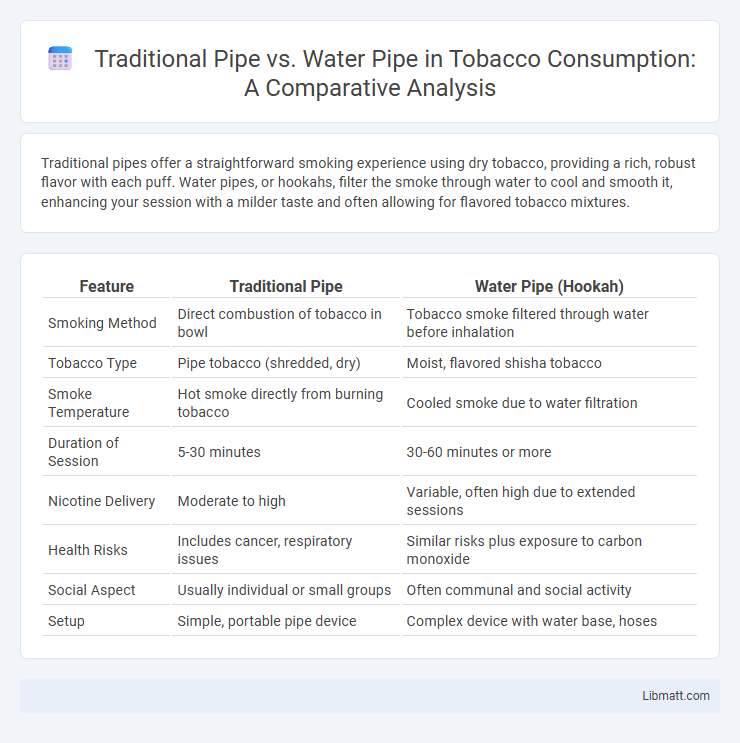Traditional pipes offer a straightforward smoking experience using dry tobacco, providing a rich, robust flavor with each puff. Water pipes, or hookahs, filter the smoke through water to cool and smooth it, enhancing your session with a milder taste and often allowing for flavored tobacco mixtures.
Table of Comparison
| Feature | Traditional Pipe | Water Pipe (Hookah) |
|---|---|---|
| Smoking Method | Direct combustion of tobacco in bowl | Tobacco smoke filtered through water before inhalation |
| Tobacco Type | Pipe tobacco (shredded, dry) | Moist, flavored shisha tobacco |
| Smoke Temperature | Hot smoke directly from burning tobacco | Cooled smoke due to water filtration |
| Duration of Session | 5-30 minutes | 30-60 minutes or more |
| Nicotine Delivery | Moderate to high | Variable, often high due to extended sessions |
| Health Risks | Includes cancer, respiratory issues | Similar risks plus exposure to carbon monoxide |
| Social Aspect | Usually individual or small groups | Often communal and social activity |
| Setup | Simple, portable pipe device | Complex device with water base, hoses |
Introduction to Traditional Pipes and Water Pipes
Traditional pipes, often crafted from wood or briar, have been used for centuries to smoke tobacco, offering a classic experience with manual lighting and natural airflow. Water pipes, commonly known as hookahs or bongs, use water filtration to cool and filter smoke, providing a smoother inhalation typically shared in social settings. Your choice between these depends on preference for portability and flavor intensity versus filtration and communal use.
Historical Overview of Smoking Methods
Traditional pipes have been used for smoking tobacco since ancient times, with origins tracing back to indigenous cultures in the Americas and early civilizations in Europe and Asia. Water pipes, also known as hookahs or shishas, originated in the Indian subcontinent during the 16th century and gained popularity across the Middle East and North Africa for their unique water filtration and social smoking experience. The historical evolution of these methods reflects diverse cultural practices and technological adaptations in the consumption of tobacco and other smoking substances.
Design and Construction Differences
Traditional pipes are typically made from metals such as copper or steel and feature rigid, cylindrical designs suited for high-pressure systems. Water pipes, often constructed from materials like PVC, CPVC, or PEX, emphasize corrosion resistance and flexibility to accommodate various plumbing configurations. The construction of water pipes incorporates seamless joints and smooth interiors to optimize flow efficiency and reduce the risk of contamination.
Materials Used in Traditional vs Water Pipes
Traditional pipes are typically crafted from materials like briar wood, meerschaum, and corncob, prized for their heat resistance and natural aesthetics. Water pipes, also known as bongs, predominantly use glass, silicone, or acrylic to facilitate filtration and cooling of the smoke through water chambers. Your choice of material directly influences the durability, flavor purity, and maintenance requirements of the pipe.
Mechanism of Smoke Filtration
Traditional pipes filter smoke primarily through burning the tobacco directly, with minimal filtration, allowing more tar and toxins to reach your lungs. Water pipes, or hookahs, use water to cool and partially filter the smoke, trapping some impurities and reducing harshness, though not entirely eliminating harmful substances. The water filtration mechanism in water pipes provides a smoother inhalation experience compared to the direct smoke intake of traditional pipes.
Health Implications and Safety Concerns
Traditional pipes produce combustion byproducts including tar, carbon monoxide, and carcinogens that may pose significant health risks such as respiratory issues and cancer. Water pipes, or hookahs, filter smoke through water but still expose users to harmful toxins, heavy metals, and nicotine, potentially leading to lung disease and cardiovascular problems. Understanding these health implications helps you make safer choices by recognizing that neither option is risk-free.
Flavor and Smoking Experience Comparison
Traditional pipes offer a rich, robust flavor due to direct tobacco combustion, providing a warm, full-bodied smoking experience favored by purists. Water pipes, or hookahs, filter smoke through water, producing a smoother, cooler draw that reduces harshness and allows for prolonged sessions with flavored tobacco blends. Flavor intensity in traditional pipes is often stronger and more concentrated, while water pipes emphasize subtlety and variety through mixing fruit or herbal infusions.
Cultural and Social Influences
Traditional pipes, often wood or clay-based, hold deep cultural significance in indigenous and historical contexts, symbolizing rituals, spirituality, and social bonding. Water pipes, commonly known as hookahs or shishas, originate from Middle Eastern cultures and are associated with communal gatherings, relaxation, and social interaction in cafes and homes. Both smoking methods reflect distinct cultural identities and social traditions, influencing their use and perception in various societies worldwide.
Maintenance and Cleaning Requirements
Traditional pipes require regular inspection for leaks and corrosion, often needing professional maintenance to prevent blockages and water damage. Water pipes, especially those made of PVC or PEX, have lower maintenance demands but still require periodic flushing to remove mineral buildup and ensure water quality. Both systems benefit from routine cleaning protocols to extend lifespan and maintain efficient water flow.
Choosing the Right Pipe: Factors to Consider
Selecting the right pipe for your smoking preference involves considering factors such as material durability, flavor purity, and maintenance requirements. Traditional pipes, often made of briar or meerschaum, offer a classic taste experience and heat resistance, while water pipes provide smoother, cooler hits by filtering smoke through water. Your choice should balance portability, ease of cleaning, and desired smoking intensity to optimize satisfaction.
Traditional pipe vs Water pipe Infographic

 libmatt.com
libmatt.com